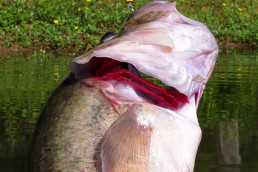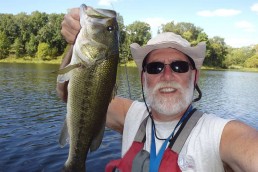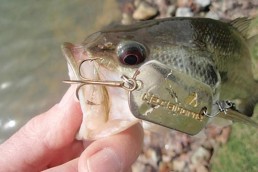Timing the Topwater Strike
SHARE THIS POST
In one respect, surface lures are the easiest artificial baits to fish because you can see what’s happening. It’s not like other forms where a developed sense of feel is imperative. When the water explodes, anyone can get the exciting and immediate message that they’ve got a bite.
On the other hand, this visual stimulation actually works against us when it comes to hooking and holding fish. Because we can see it happen and because bass are so sudden and showy about it, most of us react too quickly and literally jerk the bait out of a fish’s mouth. It’s a normal reaction and hard to control, but if you can wait a second or so from the time a fish inhales a topwater bait and you hammer the hooks home, you’ll snag it and bring to hand a lot more fish.
It all has to do with the way a bass attacks things on the surface. I’ve observed this many times in clear water. They always approach from the rear or at most a few degrees from one side or the other, but mostly from the rear. This makes a lot of sense. If you want to capture something, you sneak up behind it, instead of rushing headlong or from the side where the thing could see you coming and dodge the attack.
Bass also don’t rush up to take a bait the way some fishermen assume they do. Very small fish will do that sometimes, but any decent bass will close in on a surface bait just slightly faster than at the pace the bait itself is moving at, stalking it or ambushing it. This depends, of course, on how fast you’re fishing the bait, but most of the time they stalk so close to a bait that they’re nearly touching it before they make their final commitment.
This is especially true with poppers, chuggars, Spooks and similar baits that make a lot of commotion in a small area. But even with the popular buzzbaits that most of us fish too fast, rarely are bass more than their own body length away when they make those quick movements that mess up the water.
The whole process is methodical, precise and surprisingly slow–except for the actual split second of the capture, which with a bass is all mouth.
The only rapid movement of their surface-feeding technique is when they actually suck the bait in. This is done with such blinding speed that you almost have to see it in slow motion to tell exactly what is happening. They’ll turn their heads slightly, open their mouths wide and create a vacuum by instantly sucking water into their mouths and blowing it out through their gill covers as they close their mouths on the bait. The bigger the fish, the faster it seems to happen.
Are you enjoying this post?
You can be among the first to get the latest info on where to go, what to use and how to use it!
The sudden disturbance you see, and the “kerploosh” that you hear, is all created by this split-second suction. But it’s so rapid and calamitous it often startles us into striking too soon. Even when I’m expecting it, the violence of this action often takes me by surprise.
As soon as the lure is inhaled, however, everything slows down again as the fish no longer needs quick movements. It has the bait in its mouth, but at this point the bait is just inside its lips, and not in its throat. For the first second or two after a bass vacuums in a topwater bait, it’s still facing the fisherman. So a quick reaction tends to pop the lure straight out of the fish’s face, even if it has its mouth closed at the time. The amount of time between the first visual indication of the strike and when the bass turns away and heads back down is brief, but it can seem like forever, and is why I call it the “one-second eternity.”
This is when a fisherman’s hands tighten around his rod and every muscle in his body tenses like a slugger waiting for a fastball to come in over the plate though he’s not sure he’s going to get one. If he swings the nanosecond he sees the ball leave the pitcher’s hand, he’ll likely miss it. So, he needs to wait on it. Then, at exactly the right moment, he swings quickly through the hitting zone, making the ball hit the sweet spot on the bat. This is how an experienced fisherman reacts to a surface strike. If he can wait until the bass turns down and away, he’ll hook nearly every one of them deeply and securely because he will be pulling the bait into the side of the its mouth, or sweet spot, and not out the front of it. If he can control himself for this one-second eternity, he’ll land a lot more of them, simply because the hooks will be more securely imbedded into the fish’s jaw. Most bass get away, regardless of method, when they leap clear of the water. And, they seem to leap the most when they’re caught on top. Maybe it’s because they’re already near the surface when you hook them or they figure that because whatever bit them back came from the surface, so they can then get rid of it in the same place.
At any rate, bass hooked near the surface most often go acrobatically insane, trying to tail-walk their way to freedom. You can drop the rod tip and pull it to the side to cut down on the slack that most often allows them to shake free, but the best insurance is a solid hook-set in the first place.
All these aerial antics are a visual delight that puts a big smile on my face. Savage surface strikes from bass tickle my fishing bone, and I’m most amused when one of them comes all the way out of the water to pounce on my lure on the way down. That still unnerves me, and even though I know better, I still sometimes react too quickly.
At times, one second or so can seem like an eternity, but it is the most exciting second in all of fishing.
MWO
SHARE THIS POST
Did you enjoy this post?
You can be among the first to get the latest info on where to go, what to use and how to use it!
Ron Kruger
Ron Kruger has been communicating the outdoor experience for more than four decades. He has worked as a full-time guide for trout on the North Fork, for crappies and bass on Kentucky Lake and for smallmouths on the Current River. He has served as editor of three outdoor magazines, and owns a patent on a fly/lure called the Desperate Diver.




